Chapter 20. Pathogenesis and Treatment of Alopecias
January 1989
in “Annual Reports in Medicinal Chemistry”
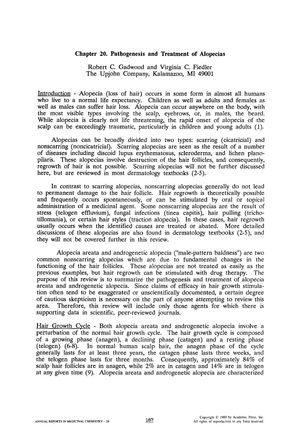
TLDR Hair loss from alopecia areata and androgenetic alopecia can be treated, but more effective and safer treatments are needed.
The 1989 document reviews the causes and treatments of alopecia areata and androgenetic alopecia. Alopecia areata, which can lead to unpredictable hair loss, is linked to immune system disturbances and can be treated with corticosteroids, contact allergens, irritants, PUVA therapy, immunostimulants, immunosuppressants, and sometimes minoxidil. Androgenetic alopecia, affecting both sexes, is influenced by genetic factors and characterized by hair follicle miniaturization and increased telogen phase follicles. Treatments include antiandrogens for females and a 5α-reductase inhibitor tested in monkeys, with topical minoxidil showing moderate or dense regrowth in 39% of over 2,300 subjects in a study. The document emphasizes the need for more effective and safe hair growth treatments and a better understanding of their mechanisms.
View this study on sciencedirect.com →
Cited in this study

research Minoxidil Stimulates Mouse Vibrissae Follicles in Organ Culture
Minoxidil can help grow hair in mice by making cells grow and improving hair quality. More research needed.
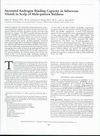
research Increased Androgen Binding Capacity in Sebaceous Glands in Scalp of Male-pattern Baldness
Men with male-pattern baldness have more androgen receptors in their scalp's oil glands, which may contribute to hair loss.
research Animal models of alopecia

research Topical minoxidil: cardiac effects in bald man.
Using topical minoxidil for baldness can cause heart problems, especially in those with heart disease.
research Retinoids: Compounds important to hair growth
Retinoids might help hair grow and improve hair loss treatments.

research Androgenetic alopecia, trichotrophic substances, and histologic studies of the human scalp
Minoxidil promotes hair growth but exact mechanism is unknown.
research Topical antiandrogens in the treatment of male-pattern baldness
Topical antiandrogens might be a good option for male-pattern baldness with fewer side effects, but more research is needed to confirm their safety and effectiveness.

research The history of the development of minoxidil
Minoxidil was first made for high blood pressure, but it was later found to help hair growth.
research The effect of testosterone, cyproterone acetate, and minoxidil on hair loss in the androchronogenetic alopecia mouse
The mouse model could be useful for baldness research and testing treatments like testosterone, cyproterone acetate, and minoxidil.

research The stumptailed macaque as a model for androgenetic alopecia: Effects of topical minoxidil analyzed by use of the folliculogram
The study used monkeys to test a hair loss treatment called minoxidil, which showed positive results.
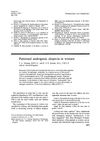
research Patterned androgenic alopecia in women
"Male-pattern" hair loss is common in women, especially after menopause, and doesn't always mean there's a problem with hormone balance.

research Selective inhibition by minoxidil of prostacyclin production by cells in culture
Minoxidil stops cells from making prostacyclin, which may help with hair growth. More research is needed.
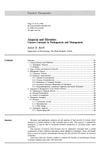
research Alopecia and Hirsuties
The document concludes that treatments for female hair loss and excessive hair growth are temporary and not well-studied.

research Sulfation of minoxidil by human platelet sulfotransferase
Human platelets change minoxidil to minoxidil sulfate, helping blood vessels widen.
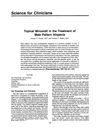
research Topical Minoxidil in the Treatment of Male Pattern Alopecia
Minoxidil can help thicken hair in some people with male pattern baldness, especially if used early and continuously.

research Evaluation of Oral Minoxidil in the Treatment of Alopecia Areata
Oral minoxidil helps hair regrowth in 80% of alopecia patients, but only 18% see cosmetic improvement.
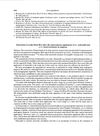
research Alterations in scalp blood flow after the epicutaneous application of 3% minoxidil and 0.1% hexyl nicotinate in alopecia
Minoxidil didn't increase scalp blood flow for hair growth, but hexyl nicotinate did.
research Sex hormone-binding globulin (SHBG) and androgen levels in women with androgenetic alopecia

research Topical minoxidil (3%) in extensive alopecia areata, including long-term efficacy
3% topical minoxidil effectively treats extensive alopecia areata with few side effects.

research Effect of minoxidil on pre- and postconfluent keratinocytes
Minoxidil prolongs cell life, slows aging, and may produce longer hairs.

research Double-blind, placebo-controlled evaluation of topical minoxidil in extensive alopecia areata
Minoxidil helps hair growth in 63.6% of alopecia patients, with 27.3% having excellent results.

research Action of topical minoxidil in the bald stump-tailed macaque
Minoxidil promotes hair growth but stops working when discontinued.

research Topical minoxidil solution (1% and 5%) in the treatment of alopecia areata
Minoxidil solution helps hair regrowth in alopecia areata, with 5% being more effective.

research Treatment of Female Androgenetic Alopecia With Cimetidine
A drug called cimetidine can help treat hair loss in women by blocking androgen receptors. However, it's not the first choice and needs more research.

research Topical Minoxidil
Minoxidil promotes hair regrowth, but more research needed for effectiveness and response factors.

research Topical Minoxidil in Extensive Alopecia areata, Including 3-Year Follow-Up
Topical minoxidil effectively and safely treats extensive alopecia areata but doesn't change its course.
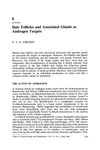
research 8 Hair follicles and associated glands as androgen targets
Androgens like testosterone affect hair growth and oil production differently across body parts and individuals.

research Topical Minoxidil Dose-Response Effect in Alopecia Areata
Higher minoxidil concentration (5%) works better for severe hair loss, with most patients seeing regrowth in 48-60 weeks.
research Topical photochemotherapy for alopecia areata
Topical PUVA can cause temporary hair regrowth in some alopecia areata patients but doesn't change the long-term outcome.

research In Vitro Suppression of Human Lymphocyte Activity by Minoxidil
Minoxidil may help hair growth by stopping immune system attacks on hair follicles.
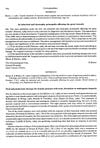
research Oral spironolactone therapy for female patients with acne, hirsutism or androgenic alopecia
Spironolactone is effective for treating acne, hirsutism, and androgenic alopecia in women with few side effects.
Related
research Reply to: “Comment on: Bicalutamide Improves Minoxidil-Induced Hypertrichosis in Female Pattern Hair Loss: A Retrospective Review of 35 Patients”

research Diffuse hypertrichosis during treatment with 5% topical minoxidil
5% topical minoxidil can cause severe body hair growth, which disappears after stopping treatment.

research Generalized hypertrichosis after treatment with topical minoxidil
Too much topical minoxidil can cause excessive hair growth, but stopping treatment reverses it.

research Topical minoxidil for hair regrowth
5% minoxidil helps hair regrowth in androgenic alopecia.
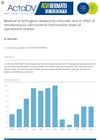
research Reversal of androgenic alopecia by minoxidil: lack of effect of simultaneously administered intermediate doses of cyproterone acetate
Minoxidil caused hair regrowth, but cyproterone acetate did not maintain it.
research Reversal of androgenic alopecia by minoxidil: lack of effect of simultaneously administered intermediate doses of cyproterone acetate.

research Hypertrichosis due to minoxidil
Minoxidil causes excessive hair growth in almost all patients.

research Minoxidil-induced hypertrichosis: treatment with calcium thioglycolate depilatory.
Minoxidil, a blood pressure drug, can cause excessive hair growth, but this can be successfully treated with a hair removal agent called calcium thioglycolate.